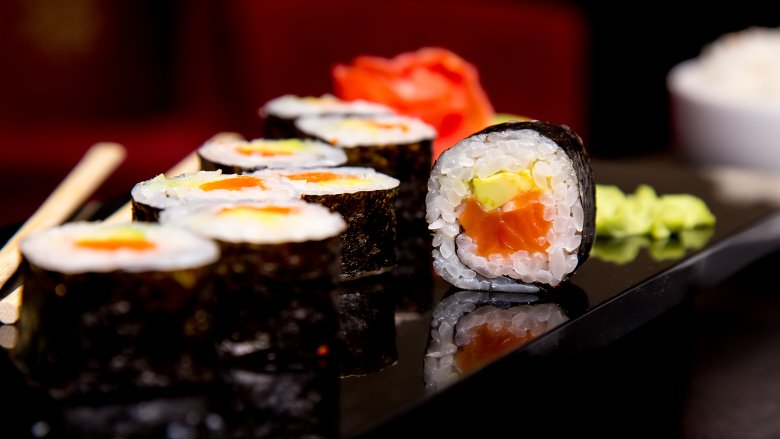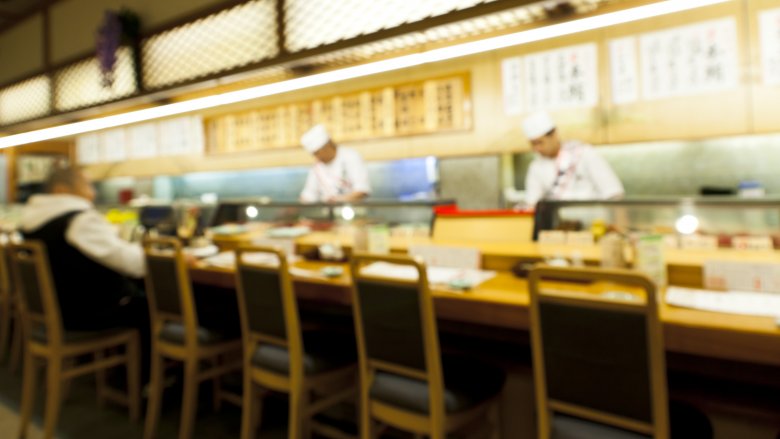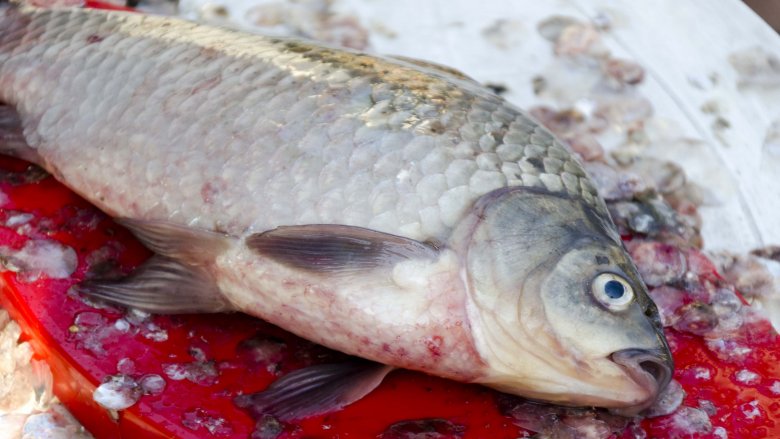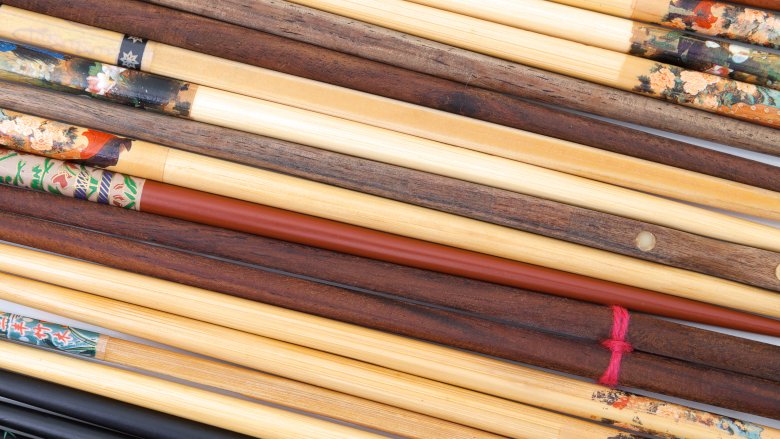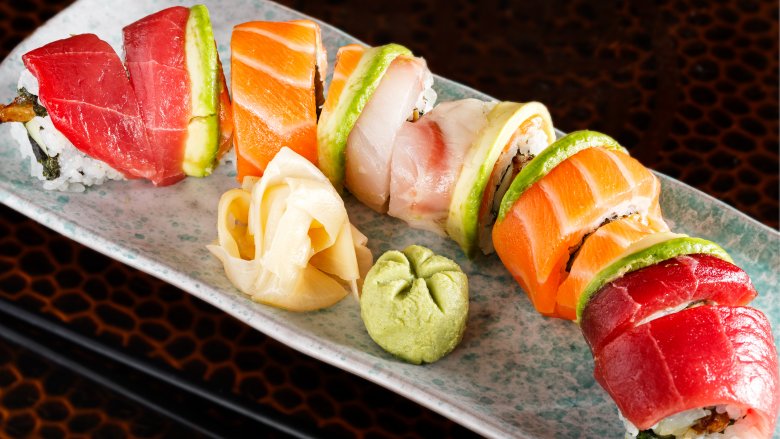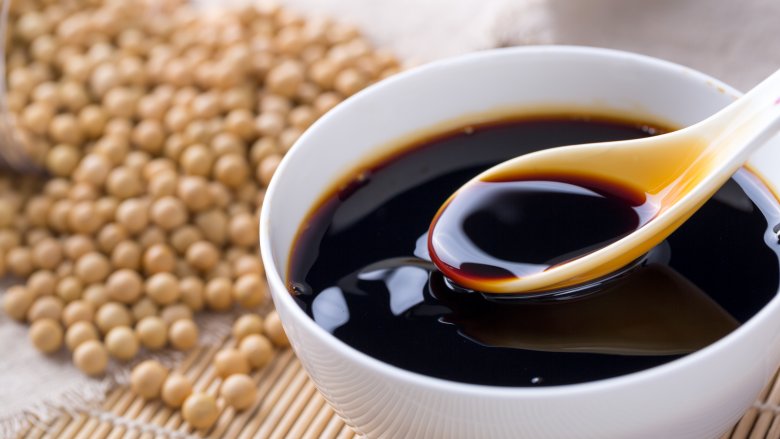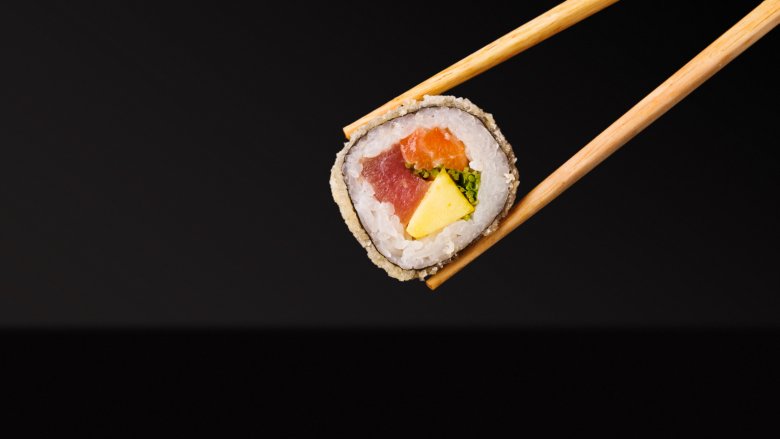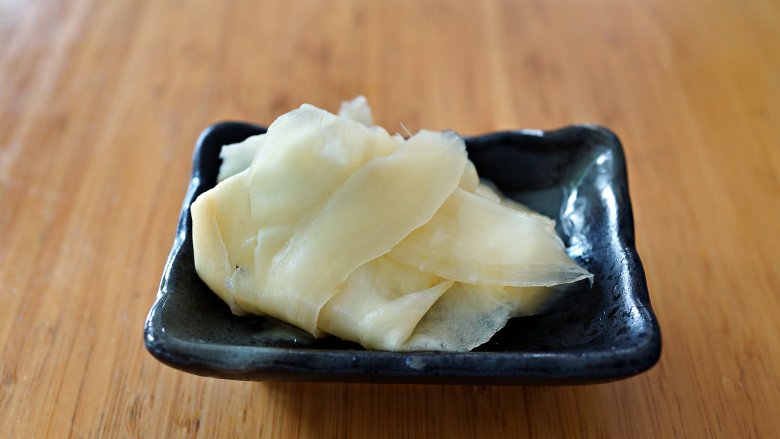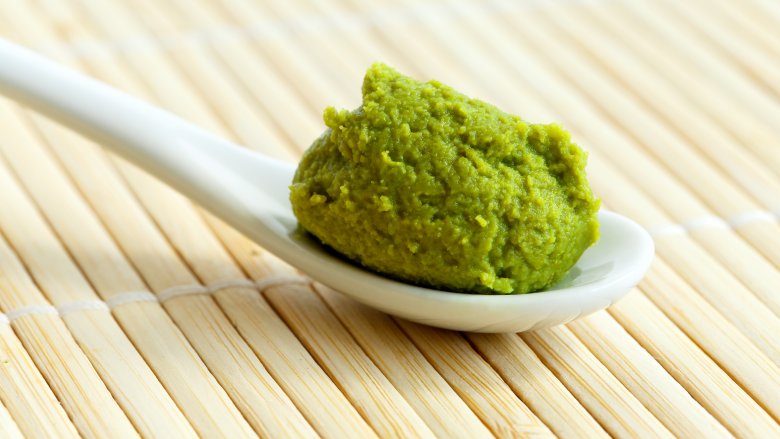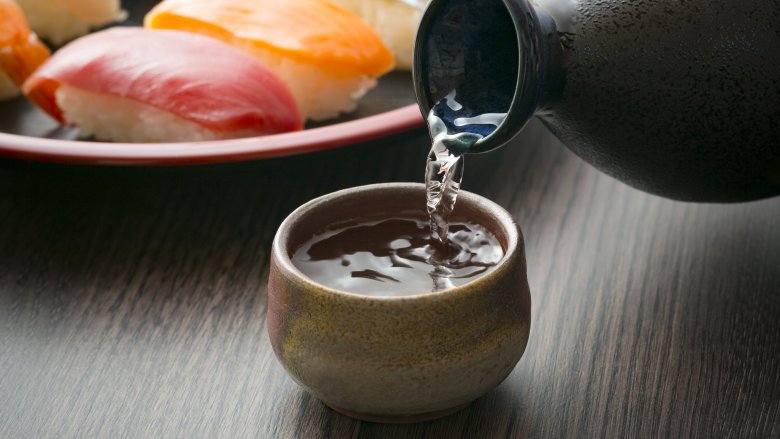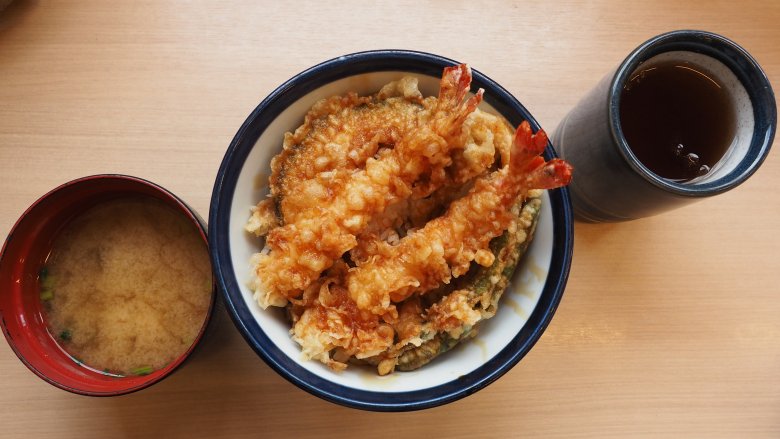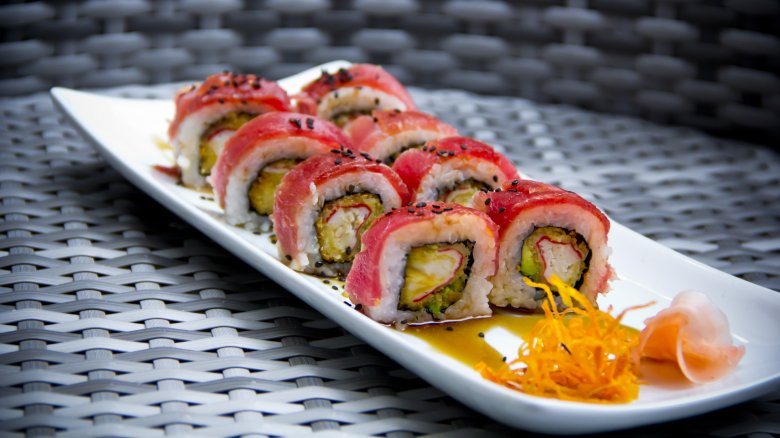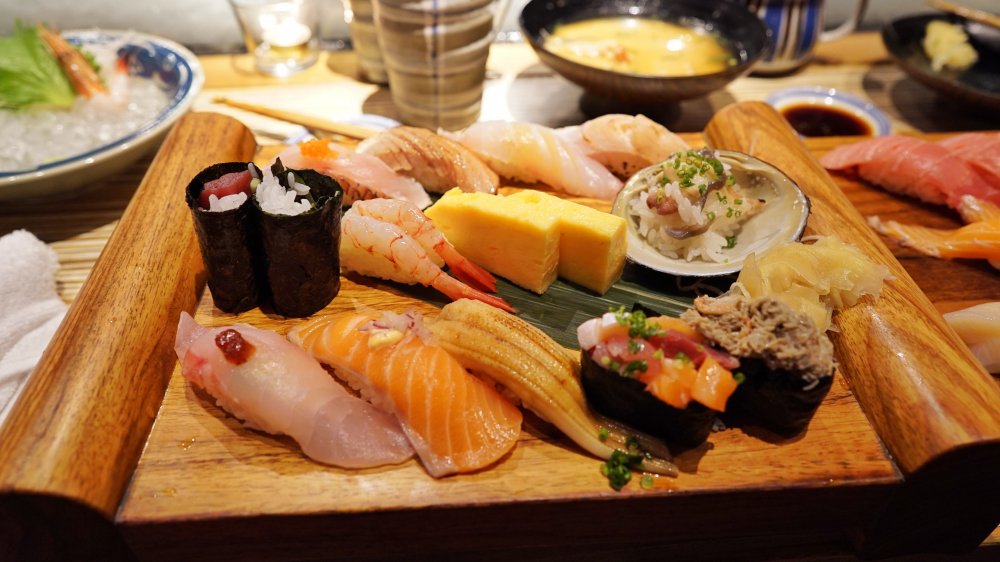What You Need To Know Before You Order Sushi Again
Unless you really, really don't like fish, there's a good chance you've had sushi recently — and, if you haven't, you're probably kind of wishing you had. After all, it's a damn lovable type of dish. Raw fish: good. Rice: good. Vegetables: good. What's not to love? On top of that, it's colorful, surprisingly filling and, if eaten properly, pretty healthy too.
Take note of those two words, though: "eaten properly." No matter where you are in the world, eating sushi takes a little more concentration than most other things, and there are plenty of ways to be led astray. You might end up with some bad fish, you might overdo the wasabi — or you might even break a rule of etiquette and offend the person who's served it up to you. In many ways, enjoying sushi is much like enjoying wine. There are steadfast rules and helpful guidelines to take note of, and getting it right will always result in a tastier, healthier and more rewarding experience.
Choose your restaurant wisely if you're going to order sushi
Like any speciality food — be it BBQ, Chinese, Italian or whatever — half of getting sushi right is knowing where to eat. It's all too easy to assume that, because it's a fairly complex food to make, anywhere that serves sushi must naturally be a reputable, quality establishment. This is not the case. At best, a sub-par sushi restaurant will leave you bitterly disappointed. At worst, it'll leave you bedridden for weeks.
According to Tablespoon, there are a few telltale signs to look out for to make sure your choice of eatery is a good one. Don't assume a high price means excellent food, for example, because plenty of places will be more than happy to rip you off. That said, avoid all-you-can-eat sushi — it's usually not high-end stuff. Rice should never be cold, seaweed should never be soggy and, if you're able to actually smell the fish as you walk in, run the hell away. Go fresh or go home.
Try not to kill yourself when you order sushi
We probably don't need to tell you what will probably happen if you eat a load of bad raw fish. We're certain, too, that you probably don't want to become a walking demonstration. But there are a few easy ways to make sure what you're eating, at the very least, won't kill you. As we've said, a restaurant that smells of fish is a major no-go, but it's still always worth researching where you are going to eat beforehand. Find out where they get their fish from, whether it's frozen properly, if the fish is farmed or wild-caught — these are all factors which could impact on the quality of your food. It can never hurt to learn how to spot worms in fish too, though if you're in an establishment that is serving that kind of thing up to you, it may be too late to help you anyway.
There's also a general rule of thumb that you ought not to order fish, including sushi, on a Monday — because markets tend to be closed on Sundays, so the fish you're eating is unlikely to be fresh. This isn't exactly a rule to live by if you're eating in genuinely high-end places, but it's always worth keeping in mind in case you're planning on visiting the sushi equivalent of a dive bar... for some reason.
Know your sushi etiquette before you even sit down
Once you sit down at your table — and before you even see any of that delicious rainbow fish arrive — there are a couple of etiquette dos and don'ts to take heed of if you want to avoid offending your chef; this, of course, goes doubly if you're actually eating sushi in Japan. Be polite, of course, and say hi if you're greeted by a host or a chef. Don't ask the chef if something's fresh — that's insulting, and is a question better addressed to a server. Never leave food on your plate when you're finished or treat something as if you don't like it. That is, of course, another way to offend a hard-working sushi chef. Rubbing chopsticks together is a huge no, by the way — it means you're assuming they splinter easily and are therefore badly made, so not the best way to pass your time while you wait for your order to arrive.
Now, if you're stopping by your local chain sushi place for a quick bite, these rules aren't exactly going to apply. This is also true if you're eating in a heavily-westernized restaurant. If it's an old-school, Japanese-owned place, however, it's always good to know all this, and it's going to be pretty much crucial if you ever end up eating sushi in Japan. It never hurts to know!
It's important to eat sushi in the right order
Considering just how delicious sushi can be, it's very easy to tuck into a load of it without giving nary a thought to just how you're actually doing it. It's a lesser-known truth, however, that sushi demands a certain order in which you should eat it. Much like how you shouldn't drink red wine before white, for example (and you don't do that, right?), you should — according to celebrity chef Nobuyuki Matsuhisa — start with the lighter, less fatty fish first, before then proceeding on to the fattier, more oily pieces (such as salmon or mackerel). Tuna, being as rich as it is, should come basically last.
You might well have your own personal preferences when it comes to what order you eat your sushi in (and you might even prefer no order at all) but we can guarantee that sticking to this rule will add a whole new dimension to your meal.
Choose sushi made from sustainable fish
This one should go without saying. It's no secret that Japan itself has a tendency to act slightly problematically when it comes to their fishing industry, and it will probably come as no surprise that plenty of fish gets served up in sushi restaurants across the world that really ought not to be. Bluefish tuna is a big one, here: only 2.6 percent of the original population of the Pacific bluefin remains in the ocean while the Atlantic version of the species has seen at least a 50 percent drop in population. These fish aren't being allowed to reproduce before being taken out of the oceans and have yet to receive proper protection from world governments, meaning the bluefish tuna is still served in sushi restaurants around the world.
Other endangered fish include eels, skate, salmon and sea bass, but far more than those are on their way to extinction. Find out what you can and can't eat and try to order ethically when you eat sushi — or it won't be around much longer.
Go easy on the soy sauce when eating sushi
Soy sauce and sushi go together like — well, like sushi and soy sauce. To have one without the other seems almost blasphemous; or, at the very least, unfortunate. Some among us, though, might admit to being somewhat liberal with their application of the stuff to sushi, blissfully unaware that doing so can ruin your meal and insult your chef at the same time.
You see, the rice that forms part of the sushi has already been flavored with soy sauce by your chef during preparation. Not only will adding more overload the taste and cause it to fall apart, but it's also basically a way of telling whoever made it that they made it badly. Etiquette-wise, that's not exactly a great look. Only the fish part of the sushi should ever touch the soy sauce. Dip it once and eat — and nobody's feelings are going to end up hurt.
Take a bite of sushi — but only one
What would you say is the defining feature of sushi? Okay, so the fish is a pretty big part of it, but it's not vital — and neither, arguably, is the rice (especially if you're eating sashimi). That leaves only one thing: the size. Yes, sushi is small; you might even say it's bite-size. And we're not just calling it that for no reason.
A golden rule of sushi etiquette is that you're supposed to eat it in one go. Don't break it up. Don't take the fish off and eat that first. Don't take a bite and save the rest for later. Doing any of these things is not only likely to cause an ungodly mess (a cardinal sin if you're eating a type of food that is specifically designed to be aesthetically pretty) but also implies that the sushi isn't of a high enough quality to eat in one bite.
That ginger's served with sushi for a reason
As you're served up with the smorgasbord of tiny, amazing, colorful fish-rice bites that we in the food world call "sushi," you might notice you're also given a bowl of strange, sweet ginger that has likely been marinated in sugar and vinegar. It might be tempting to assume that this is some sort of complement to the sushi you've ordered. It is not. Do not eat it with the sushi. People will laugh.
This kind of ginger, which is known as gari, is considered to be a vital part of the whole sushi experience. It's actually a palate cleanser, meant to reset your taste buds after each bite of sushi so that the next piece can be more fully appreciated. This is a result of the acidic nature of the ginger, which acts as an antidote to the taste of seafood. Use it properly to enhance your meal and avoid insulting the chef.
Learn how to handle your wasabi when you eat sushi
Ah, wasabi. This sibling of horseradish and mustard is a stalwart part of Japanese cuisine and a vital inclusion in any good sushi meal. Not only does it add a dollop of fire to your fish, but it's also got a few health benefits to sweeten the deal. As you'd expect, there are a few etiquette rules when it comes to how you use it — the biggest being that you should never mix it with soy sauce because it ruins the flavor of both.
We'll assume that you're firmly on the etiquette train by now, though. Instead, it's worth knowing some of the things you can do to alleviate the pressure should your wasabi prove just a bit too hot for you — let's face it, it's happened to us all. Make sure to breathe in through your nose and out of your mouth, in order to disperse the vapors more effectively. Drinking the heat away is far easier than, say, with chilies, so try taking a sip of water or soda after you eat it (or a sip of tea beforehand). Otherwise, just remember to take it easy — and, if you can, allow your chef to guide your application of wasabi to the sushi. They know best.
For goodness' sake, forget the sake when you order sushi
It seems like a natural thing to do, to pair up sake with sushi. After all, they're both Japanese, so they should fit hand-in-hand, right? Well, no. Despite the fact that Americans seem to love drinking Japan's favorite rice-based drink with their sushi — the U.S. actually constituting the world's biggest export market for it — you really are better off without it. Most sakes aren't particularly acidic, meaning they can seem quite flat and bland when paired with sushi rice, fish and soy sauce (all of which are highly acidic). Equally, some sakes, which are rich in weight and texture, can dull the more subtle aspects of your sushi's taste.
If you do want to pair an alcoholic drink with your sushi, why not give Champagne a try? A good Blanc de Blancs will bring out the briny aromas and the smooth textures of raw fish, while a rosé Champagne will complement the fish flavors nicely while simultaneously counter-balancing the soy sauce. As if sushi wasn't expensive enough, right?
Remember, not all sushi is healthy
In recent years, sushi has garnered something of a reputation for itself as a supremely healthy food. And why shouldn't it? Fish is good for you, after all, being chock-full of essential oils, vitamins and other do-good things. And it's true that sushi can be very good for you, too. The mistake you want to avoid, however, is assuming that it's good for you.
Sushi can mean many things. Some of them are healthy and some of them aren't. Sushi with fresh fish, for example, is a plus — doubly so if vegetables are involved. Overdoing the sauces, however, is not so good, and neither is anything deep fried (so keep away from tempura). And don't forget that some fish can be high in mercury — luckily, though, they're usually the endangered ones, so it's not like you're really missing out. Finally, try to remember to live in moderation: surviving on sushi alone will be no survival at all.
Try something new when you order sushi
Perhaps the most important thing to remember with sushi is this: be adventurous. It's a fascinating style of cooking that's exciting, pretty and tasty all at the same time. Why would you ever want to get stuck in a routine? If you're eating California rolls, salmon and pretty much nothing else, perhaps it's try to start branching out into something more unusual.
Among some of sushi's more novel breeds are dragon rolls (eel, cucumber and avocado), spider rolls (soft shell crab tempura with cucumber) and futomaki (oh, so many things in that one). Or you could shake up your usual dishes by having them made with soy paper or cucumber. If all else fails, just ask your chef for something new and interesting — they'll be more than happy to oblige you. Make the effort to push the boat out and you never know what you'll find — and, at the very least, you'll have embraced the sense of adventure that makes sushi so appealing in the first place. You can't lose.
Know the difference between cheap and expensive sushi
Everyone who has ever been to a gas station will know that there's nothing worse than cheap sushi. For one thing, it tastes horrible — but that's not the half of it. The truth is, cheap sushi can be dangerous, too.
In 2012, The Atlantic discovered that a type of "minced tuna" produced in India and shipped to California had been made in a processing facility that was criticized by the FDA for using filthy, contaminated tanks, failing to ensure the safety of the ice water used in the facility, and allowing bird feces and insects to come into contact with machinery. This was one kind of tuna coming from only one facility — so it's likely not the norm. Still, it demonstrates that you never know what you're really getting with cheap sushi. And fish is hardly something you want to take a risk with.
Expensive sushi, however, is usually more than worth the money. In 2015, food writer and sushi expert Trevor Corson advised Thrillist that you're better off splurging on good sushi once than eating bad sushi sushi regularly. And that means not just avoiding the bad sushi, but staying away from the mediocre stuff, too; the kind that comes from middle-of-the-road sushi joints. At those places, you'll find sushi made from refrigerated fish that's not as fresh as what's in the good stuff — usually meaning there's a lot less flavor. "Cut those out," Trevor says, "and you'll have more money to spend at a good sushi bar less frequently."
